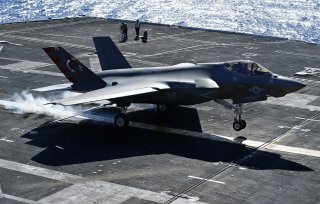This F-35C Stealth Fighter Will Be the Star of the Navy’s Sea Strategy
The Navy aims to replace its aging inventory of over five hundred Super Hornets with a planned procurement of 273 F-35C jets, reimagining the carrier air wing on the advanced foundation of fifth-generation capabilities.
Lockheed Martin’s F-35 Lightning II fifth-generation fighter jet is widely known for its F-35A conventional takeoff and landing variant, and for good reason: the Air Force plans to purchase as many as 1,763 such planes, making it the most numerous fighter in Air Force’s inventory. But the Navy and Marine Corps have invested heavily into the plane’s two specialized variants, the F-35B and F-35C, which bring unique capabilities of their own to further enhance the power-projection tools available to the U.S. military. Here is what the F-35C is for, and what it can do.
The F-35C is the Navy’s first carrier-based fifth-generation stealth fighter jet. The jet reached initial operating capability in February 2019 and is the last of the three F-35 variants to be formally introduced into service. Boasting larger folding wings, tougher landing gear, and greater fuel capacity than its F-35A counterpart, the F-35C is designed for catapult assisted take-off but arrested recovery (CATOBAR) roles in carrier strike groups. The folding wingtips save space on carrier decks, as the F-35C has a considerably larger wing area than its F-35A and F-35B counterparts.
At eighteen thousand versus fifteen thousand pounds, the F-35C boasts a greater maximum payload than the Marine Corps’ F-35B. The fighter also supports a combat radius of 670 nautical miles, as compared with the F-35B jet’s radius of 505 nautical miles. The F-35C will bring a vast leap in capabilities over the Navy’s current workhorse carrier-based fighter, the Boeing F/A-18E/F Super Hornet. The Super Hornets have an unrefueled combat radius of just under four hundred nautical miles, aircraft carriers deploying these aging fighters increasingly risk putting themselves within striking distance of the latest Russian and Chinese anti-ship missiles. The F-35 jet’s greater combat radius makes it easier for carrier air wings to project power at safer distances and enhances the wing’s battlespace persistence. The upcoming MQ-25 Stingray uncrewed aerial refueling drone can extend the ranges of both the F-35C and Super Hornet by up to an additional four hundred miles, but the initial range deficit between the two fighters persists.
The benefits don’t end there. The F-35C expands the scope of tactical possibilities available to carrier air wings, making it easier to strike multiple targets in a single sortie and to pursue deep penetration missions that would have been deemed impractical or too risky for fourth-generation aircraft. It also acts as a force multiplier for the rest of the carrier strike group, leveraging its sensor fusion capabilities to generate detailed and accurate battlefield information that can be shared with all networked ground, air, and sea assets. As with the two other F-35 variants, the F-35C provides an exceptional degree of payload flexibility. Its internal armament configuration ensures potent stealth performance against the most sophisticated enemy air defenses, while its external weapons loadout sacrifices some degree of observability to unleash the plane’s firepower to its fullest degree.
The Navy aims to replace its aging inventory of over five hundred Super Hornets with a planned procurement of 273 F-35C jets, reimagining the carrier air wing on the advanced foundation of fifth-generation capabilities.
Mark Episkopos is a national security reporter for the National Interest.
Image: Reuters

